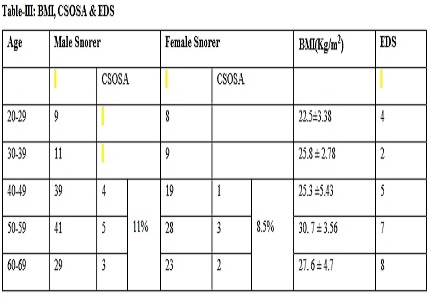Study on snoring habit in healthy population of Eastern Odisha
Abstract
Introduction: Snoring caused due to relaxation of upper airway tract leading to partial closure of the respiratory passage and characteristic snoring sound with reduced oxygen entry into lungs. Estimates of prevalence of snoring ranges from 5-44% of the general population. As per the gender distribution 24 - 50% men &14 - 30% women had snoring habits.
Methods: It was single Centre cross sectional study done by Department of Physiology, IMS & SUM Hospital in apparently healthy attendants accompanying patients using ‘Snore Survey’ questionnaire, Berlin Questionnaire.
Results: There were 550 participants. Out of which 59.72% of men, 40.20% of women snored, 47.46% from both sexes were unaware of their snoring habit. 25.6% of all snorers confirmed daytime sleepiness. Prevalence of snoring increased in both sexes with increase in age. In males, the highest prevalence rate of snoring was obtained in the age group 50 -59, out of which 19.5% had moderate and 14.6% had habitual snoring.10.6% of the males in the age group 55–69 years had clinically suspected Obstructive Sleep Apneas. For females, the highest prevalence rate of snoring occurred at age 40-49years with 17.8% having moderate and 7.1% habitual snoring, whereas clinically suspected Obstructive Sleep Apneas among the female was 8%.
Conclusion: Snoring a commonly ignored problem in our society, unless treated leads to risk of metabolic syndrome, Diabetes, CVS diseases like Hypertension, Arrhythmias& death.
Downloads
References
2. Ng TP, Seow A, Tan WC. Prevalence of snoring and sleep breathing-related disorders in Chinese, Malay and Indian adults in Singapore. Eur Respir J. 1998 Jul;12(1):198-203. [PubMed]
3. Jones TM, Swift AC. Snoring: recent developments. Hosp Med. 2000 May;61(5):330-5. [PubMed]
4. Rochester, MN, American Sleep Disorders Association, 2001.Obstructive sleep apnea syndrome. In: American Sleep Disorders Association, eds. The International Classification of Sleep Disorders, Revised: Diagnostics and Coding Manual. [PubMed]
5. Gislason T, Aberg H, Taube A. Snoring and systemic hypertension--an epidemiological study. Acta Med Scand. 1987;222(5):415-21. [PubMed]
6. Berlin questionnaire: A Screening tool for OSA.
7. Epworth Sleepiness Scale by Dr Murray Johns.
8. Young T, Palta M, Dempsey J, Skatrud J, Weber S, Badr S. The occurrence of sleep-disordered breathing among middle-aged adults. N Engl J Med. 1993 Apr 29;328(17):1230-5. [PubMed]
9. Olson LG, King MT, Hensley MJ, et al A community study of snoring and sleep-disordered breathing: prevalence. Am. J. Respir. Crit. Care Med. 1995; 152:711-716.
10. Ohayon, MM, Guilleminault, C, Priest, et al, Snoring and breathing pauses during sleep: telephone interview survey of a United Kingdom population sample. BMJ. 1997;314: 860-863. [PubMed]
11. Udwadia ZF, Doshi AV, Lonkar SG, Singh CI. Prevalence of sleep-disordered breathing and sleep apnea in middle-aged urban Indian men. Am J Respir Crit Care Med. 2004 Jan 15;169(2):168-73. Epub 2003 Nov 6. [PubMed]
12. Bloom JW, Kaltenborn WT, Quan SF. Risk factors in a general population for snoring. Importance of cigarette smoking and obesity. Chest. 1988 Apr;93(4):678-83.



 OAI - Open Archives Initiative
OAI - Open Archives Initiative


